High-flow nasal cannulae for respiratory support in adult intensive care patients
- PMID: 28555461
- PMCID: PMC6481761
- DOI: 10.1002/14651858.CD010172.pub2
High-flow nasal cannulae for respiratory support in adult intensive care patients
Update in
-
High-flow nasal cannulae for respiratory support in adult intensive care patients.Cochrane Database Syst Rev. 2021 Mar 4;3(3):CD010172. doi: 10.1002/14651858.CD010172.pub3. Cochrane Database Syst Rev. 2021. PMID: 33661521 Free PMC article.
Abstract
Background: High-flow nasal cannulae (HFNC) deliver high flows of blended humidified air and oxygen via wide-bore nasal cannulae and may be useful in providing respiratory support for adult patients experiencing acute respiratory failure in the intensive care unit (ICU).
Objectives: We evaluated studies that included participants 16 years of age and older who were admitted to the ICU and required treatment with HFNC. We assessed the safety and efficacy of HFNC compared with comparator interventions in terms of treatment failure, mortality, adverse events, duration of respiratory support, hospital and ICU length of stay, respiratory effects, patient-reported outcomes, and costs of treatment.
Search methods: We searched the Cochrane Central Register of Controlled Trials (CENTRAL; 2016, Issue 3), MEDLINE, the Cumulative Index to Nursing and Allied Health Literature (CINAHL), Embase, Web of Science, proceedings from four conferences, and clinical trials registries; and we handsearched reference lists of relevant studies. We conducted searches from January 2000 to March 2016 and reran the searches in December 2016. We added four new studies of potential interest to a list of 'Studies awaiting classification' and will incorporate them into formal review findings during the review update.
Selection criteria: We included randomized controlled studies with a parallel or cross-over design comparing HFNC use in adult ICU patients versus other forms of non-invasive respiratory support (low-flow oxygen via nasal cannulae or mask, continuous positive airway pressure (CPAP), and bilevel positive airway pressure (BiPAP)).
Data collection and analysis: Two review authors independently assessed studies for inclusion, extracted data, and assessed risk of bias.
Main results: We included 11 studies with 1972 participants. Participants in six studies had respiratory failure, and in five studies required oxygen therapy after extubation. Ten studies compared HFNC versus low-flow oxygen devices; one of these also compared HFNC versus CPAP, and another compared HFNC versus BiPAP alone. Most studies reported randomization and allocation concealment inadequately and provided inconsistent details of outcome assessor blinding. We did not combine data for CPAP and BiPAP comparisons with data for low-flow oxygen devices; study data were insufficient for separate analysis of CPAP and BiPAP for most outcomes. For the primary outcomes of treatment failure (1066 participants; six studies) and mortality (755 participants; three studies), investigators found no differences between HFNC and low-flow oxygen therapies (risk ratio (RR), Mantel-Haenszel (MH), random-effects 0.79, 95% confidence interval (CI) 0.49 to 1.27; and RR, MH, random-effects 0.63, 95% CI 0.38 to 1.06, respectively). We used the GRADE approach to downgrade the certainty of this evidence to low because of study risks of bias and different participant indications. Reported adverse events included nosocomial pneumonia, oxygen desaturation, visits to general practitioner for respiratory complications, pneumothorax, acute pseudo-obstruction, cardiac dysrhythmia, septic shock, and cardiorespiratory arrest. However, single studies reported adverse events, and we could not combine these findings; one study reported fewer episodes of oxygen desaturation with HFNC but no differences in all other reported adverse events. We downgraded the certainty of evidence for adverse events to low because of limited data. Researchers noted no differences in ICU length of stay (mean difference (MD), inverse variance (IV), random-effects 0.15, 95% CI -0.03 to 0.34; four studies; 770 participants), and we downgraded quality to low because of study risks of bias and different participant indications. We found no differences in oxygenation variables: partial pressure of arterial oxygen (PaO2)/fraction of inspired oxygen (FiO2) (MD, IV, random-effects 7.31, 95% CI -23.69 to 41.31; four studies; 510 participants); PaO2 (MD, IV, random-effects 2.79, 95% CI -5.47 to 11.05; three studies; 355 participants); and oxygen saturation (SpO2) up to 24 hours (MD, IV, random-effects 0.72, 95% CI -0.73 to 2.17; four studies; 512 participants). Data from two studies showed that oxygen saturation measured after 24 hours was improved among those treated with HFNC (MD, IV, random-effects 1.28, 95% CI 0.02 to 2.55; 445 participants), but this difference was small and was not clinically significant. Along with concern about risks of bias and differences in participant indications, review authors noted a high level of unexplained statistical heterogeneity in oxygenation effect estimates, and we downgraded the quality of evidence to very low. Meta-analysis of three comparable studies showed no differences in carbon dioxide clearance among those treated with HFNC (MD, IV, random-effects -0.75, 95% CI -2.04 to 0.55; three studies; 590 participants). Two studies reported no differences in atelectasis; we did not combine these findings. Data from six studies (867 participants) comparing HFNC versus low-flow oxygen showed no differences in respiratory rates up to 24 hours according to type of oxygen delivery device (MD, IV, random-effects -1.51, 95% CI -3.36 to 0.35), and no difference after 24 hours (MD, IV, random-effects -2.71, 95% CI -7.12 to 1.70; two studies; 445 participants). Improvement in respiratory rates when HFNC was compared with CPAP or BiPAP was not clinically important (MD, IV, random-effects -0.89, 95% CI -1.74 to -0.05; two studies; 834 participants). Results showed no differences in patient-reported measures of comfort according to oxygen delivery devices in the short term (MD, IV, random-effects 0.14, 95% CI -0.65 to 0.93; three studies; 462 participants) and in the long term (MD, IV, random-effects -0.36, 95% CI -3.70 to 2.98; two studies; 445 participants); we downgraded the certainty of this evidence to low. Six studies measured dyspnoea on incomparable scales, yielding inconsistent study data. No study in this review provided data on positive end-expiratory pressure measured at the pharyngeal level, work of breathing, or cost comparisons of treatment.
Authors' conclusions: We were unable to demonstrate whether HFNC was a more effective or safe oxygen delivery device compared with other oxygenation devices in adult ICU patients. Meta-analysis could be performed for few studies for each outcome, and data for comparisons with CPAP or BiPAP were very limited. In addition, we identified some risks of bias among included studies, differences in patient groups, and high levels of statistical heterogeneity for some outcomes, leading to uncertainty regarding the results of our analysis. Consequently, evidence is insufficient to show whether HFNC provides safe and efficacious respiratory support for adult ICU patients.
Conflict of interest statement
Sharon R Lewis (SRL), Philip E Baker (PEB), Roses Parker (RP), Andrew F Smith (AFS).
Review authors SRL, PEB, RP and AFS have no conflicts of interest to declare.
Figures



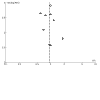
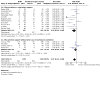

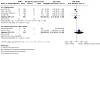
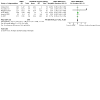
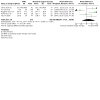
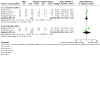

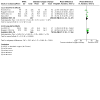
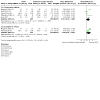
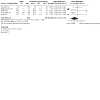




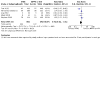


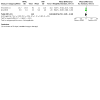



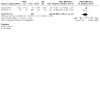


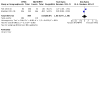
References
References to studies included in this review
Azoulay 2018 {published data only}
Brainard 2017 {published data only}
Chanques 2013 {published and unpublished data}
-
- Chanques G, Riboulet F, Molinari N, Carr J, Jung B, Prades A, et al. Comparison of three high flow oxygen therapy delivery devices: a clinical physiological cross-over study. Minerva Anestesiologica 2013;79(12):1344-55. [PMID: ] - PubMed
Cong 2019 {published data only}
-
- Cong L, Zhou LN, Liu HN, Wang JR. Outcomes of high-flow nasal cannula versus non-invasive positive pressure ventilation for patients with acute exacerbations of chronic obstructive pulmonary disease. International Journal of Clinical and Experimental Medicine 2019;12(8):10863-7.
Corley 2014 {published data only}
-
- Corley A, Bull T, Spooner AJ, Barnett AG, Fraser JF. Direct extubation onto high-flow nasal cannulae post-cardiac surgery versus standard treatment in patients with a BMI ≥ 30: a randomised controlled trial. Intensive Care Medicine 2015;41(5):887-94. [PMID: ] - PubMed
Cuquemelle 2012 {published and unpublished data}
-
- Cuquemelle E, Pham T, Papon JF, Louis B, Danin PE, Brochard L. Heated and humidified high-flow oxygen therapy reduces discomfort during hypoxaemic respiratory failure. Respiratory Care 2012;57(10):1571-7. [PMID: ] - PubMed
Fernandez 2017 {published and unpublished data}
-
- Fernandez R, Subira C, Frutos F, Rialp G, Laborda C, Masclans JR, et al. High-flow oxygen therapy for extubation failure prevention in high-risk critically ill patients: a randomized multicenter trial. Intensive Care Medicine Experimental 2015;3(Suppl 1):A164.
-
- NCT01820507. Extubation failure prevention in high risk patients by high-flow conditioned oxygen therapy vs. standard oxygen therapy [Prevention of post-extubation respiratory failure in high risk patients by high-flow conditioned oxygen therapy versus standard oxygen therapy]. clinicaltrials.gov/ct2/show/NCT01820507 (first received 28 March 2013).
Frat 2015 {published data only}
-
- Frat JP, Thille AW, Mercat A, Girault C, Ragot S, Perbet S, et al. High-flow oxygen through nasal cannula in acute hypoxemic respiratory failure. New England Journal of Medicine 2015;372(23):2185-96. [PMID: ] - PubMed
Futier 2016 {published data only}
-
- Futier E, Paugam-Burtz C, Godet T, Khoy-Ear L, Rozencwajg S, Delay JM, et al. Effect of early postextubation high-flow nasal cannula vs conventional oxygen therapy on hypoxaemia in patients after major abdominal surgery: a French multicentre randomised controlled trial (OPERA). Intensive Care Medicine 2016;42(12):1888-98. [PMID: ] - PubMed
Grieco 2020 {published data only}
-
- Grieco DL, Menga LS, Raggi V, Bongiovanni F, Anzellotti GM, Tanzarella ES, et al. Physiological comparison of high-flow nasal cannula and helmet noninvasive ventilation in acute hypoxemic respiratory failure. American Journal of Respiratory and Critical Care Medicine 2020;201(3):303-12. [PMID: ] - PubMed
Hernandez 2016a {published data only}
-
- Hernandez G, Vaquero C, Colinas L, Cuena R, Gonzalez P, Canabal A, et al. Effect of postextubation high-flow nasal cannula vs noninvasive ventilation on reintubation and postextubation respiratory failure in high-risk patients: a randomized clinical trial. JAMA 2016;316(15):1565-74. [PMID: ] - PubMed
-
- Hernandez G, Vaquero C, Gonzalez P, Colinas L, Garcia S, Canabal A, et al. High flow conditioned oxygen therapy for prevention of reintubation in critically ill patients at high risk for extubation failure: a multicenter randomised controlled trial. Intensive Care Medicine Experimental 2015;3(Suppl 1):A823.
-
- NCT01191489. High-flow conditioned oxygen therapy versus non-invasive ventilation: prevention of post-extubation failure [Comparison between high-flow conditioned oxygen therapy and non-invasive ventilation in prevention of post-extubation respiratory failure. A randomized controlled trial]. clinicaltrials.gov/ct2/show/study/NCT01191489 (first received 30 August 2010).
Hernandez 2016b {published data only}
-
- Hernandez G, Vaquero C, Gonzalez P, Subira C, Frutos-Vivar F, Rialp G, et al. Effect of postextubation high-flow nasal cannula vs conventional oxygen therapy on reintubation in low-risk patients: a randomized clinical trial. JAMA 2016;315(13):1354-61. [PMID: ] - PubMed
-
- NCT01191489. High-flow conditioned oxygen therapy versus non-invasive ventilation: prevention of post-extubation failure [Comparison between high-flow conditioned oxygen therapy and non-invasive ventilation in prevention of post-extubation respiratory failure. A randomized controlled trial]. clinicaltrials.gov/ct2/show/study/NCT01191489 (first received 30 August 2010).
Hu 2020 {published data only}
-
- Hu TY, Lee CH, Cheng KH, Tan MC, Hua HF, Kuo LK. Effect of high-flow nasal oxygen vs. conventional oxygen therapy on extubation outcomes and physiologic changes for patients with high risk of extubation failure in the medical ICU: a tertiary center, randomized, controlled trial. International Journal of Gerontology 2020;14(1):36-41. [EMBASE: 2005059557]
Jing 2019 {published data only}
-
- Jing G, Li J, Hao D, Wang T, Sun Y, Tian H, et al. Comparison of high flow nasal cannula with noninvasive ventilation in chronic obstructive pulmonary disease patients with hypercapnia in preventing postextubation respiratory failure: a pilot randomized controlled trial. Research in Nursing & Health 2019;42(3):217-25. [PMID: ] - PubMed
Lee 2018 {published data only}
-
- Lee DH, Lim CM, Koh Y, Hong SB, WonHuh J, Seo GJ, et al. Global and regional ventilation during highflow nasal cannula in patients with hypoxia. Critical Care Medicine 2016;44(12):325.
Lemiale 2015 {published data only}
-
- Lemiale V, Mokart D, Mayaux J, Lambert J, Rabbat A, Demoule A, et al. The effects of a 2-h trial of high-flow oxygen by nasal cannula versus Venturi mask in immunocompromised patients with hypoxemic acute respiratory failure: a multicenter randomized trial. Critical Care 2015;19:380. [PMID: ] - PMC - PubMed
Longhini 2019 {published data only}
-
- Longhini F, Pisani L, Lungu R, Comellini V, Fruni A, Garofalo E, et al. High-flow oxygen therapy after noninvasive ventilation interruption in patients recovering from hypercapnic acute respiratory failure: a physiological crossover trial. Critical Care Medicine 2019;47(6):E506-11. - PubMed
Maggiore 2014 {unpublished data only}
-
- Antonicelli F, Cataldo A, Festa F, Idone R, Moccaldo A, Antonelli M, et al. High-flow oxygen therapy through nasal cannulae versus low-flow oxygen therapy via venturi mask after extubation in adult, critically ill patients. In: 31st International Symposium on Intensive Care and Emergency Medicine; 2011 March; Brussels, Belgium. Brussels, Belgium, 2011.
-
- Idone FA, Festa R, Antonicelli F, Di Muzio F, Maniglia D, Cataldo A, et al. Nasal high-flow oxygen therapy vs. standard oxygen therapy via venturi mask after extubation: preliminary results of a randomized, controlled trial. In: 23rd Annual Congress of the European Society of Intensive Care Medicine (ESICM); 2010 October; Barcelona, Spain. 2010.
-
- Maggiore SM, Idone FA, Vaschetto R, Festa R, Cataldo A, Antonicelli F, et al. Nasal high-flow versus Venturi mask oxygen therapy after extubation. Effects on oxygenation, comfort, and clinical outcome. American Journal of Respiratory and Critical Care Medicine 2014;190(3):282-8. [PMID: ] - PubMed
-
- Moccaldo A, Vaschetto R, Bernini V, Antonicelli F, Festa R, Idone F, et al. Oxygen after extubation: comparison between high flow system (Optiflow) and Venturi mask [Ossigenoterapia dopo estubazione: confronto tra sistema ad alti flussi (Optiflow) e maschera venturi]. Minerva Anestesiology 2011;77(10 Suppl 2):169.
Mauri 2017a {published data only}
-
- Mauri T, Alban L, Turrini C, Cambiaghi B, Carlesso E, Taccone P, et al. Optimum support by high-flow nasal cannula in acute hypoxemic respiratory failure: effects of increasing flow rates. Intensive Care Medicine 2017;43(10):1453-63. [PMID: ] - PubMed
Mauri 2017b {published data only}
-
- Mauri T, Turrini C, Eronia N, Grasselli G, Volta CA, Bellani G, et al. Physiologic effects of high-flow nasal cannula in acute hypoxemic respiratory failure. American Journal of Respiratory and Critical Care Medicine 2017;195(9):1207-15. [PMID: ] - PubMed
Parke 2011 {published and unpublished data}
-
- Parke RL, McGuinness SP, Eccleston ML. A preliminary randomised controlled trial to assess effectiveness of nasal high-flow oxygen in intensive care patients. Respiratory Care 2011;56(3):265-70. [PMID: ] - PubMed
Parke 2013a {published and unpublished data}
-
- Parke R, McGuinness S, Dixon R, Jull A. Open-label, phase II study of routine high-flow nasal oxygen therapy in cardiac surgical patients. British Journal of Anaesthesia 2013;111(6):925-31. [PMID: ] - PubMed
Rittayamai 2014 {published and unpublished data}
-
- Rittayamai N, Tscheikuna J, Rujiwit P. High-flow nasal cannula versus conventional oxygen therapy after endotracheal extubation: a randomized crossover physiologic study. Respiratory Care 2014;59(4):485-90. [PMID: ] - PubMed
Schwabbauer 2014 {published data only}
-
- Riessen R, Schwabbauer N, Berg B, Blumenstock G, Haap M, Hetzel J. Nasal high-flow oxygen in patients with hypoxic respiratory failure: effect of functional and subjective respiratory parameters compared to conventional oxygen therapy and noninvasive ventilation. In: 32nd International Symposium on Intensive Care and Emergency Medicine; 2012 March; Brussels, Belgium. 2012.
-
- Schwabbauer N, Berg B, Blumenstock G, Haap M, Hetzel J, Riessen R. Nasal high-flow oxygen therapy in patients with hypoxic respiratory failure: effect on functional and subjective respiratory parameters compared to conventional oxygen therapy and non-invasive ventilation (NIV). BMC Anesthesiology 2014;14(66):1-7. [PMID: ] - PMC - PubMed
Shebl 2018 {published data only}
-
- Shebl E, Embarak S. High-flow nasal oxygen therapy versus noninvasive ventilation in chronic interstitial lung disease patients with acute respiratory failure. Egyptian Journal of Chest Diseases and Tuberculosis 2018;67(3):270-5. [EMBASE: 625864420]
Song 2017 {published data only}
Stephan 2015 {published data only}
-
- Stephan F, Barrucand B, Petit P, Rezaiguia-Delclaux S, Medard A, Delannoy B, et al. BiPAP non invasive ventilation compared to Optiflow® system in patients with hypoxemia after cardiothoracic surgery: multicenter, randomized, non-inferiority and open (BiPOP study). Annales Francaises d'Anésthesie et de Réanimation 2014;33:A72.
-
- Stephan F, Barrucand B, Petit P, Rezaiguia-Delclaux S, Medard A, Delannoy B, et al. High-flow nasal oxygen vs noninvasive positive airway pressure in hypoxemic patients after cardiothoracic surgery: a randomized clinical trial. JAMA 2015;313(23):2331-9. [PMID: ] - PubMed
-
- Stephan F, Barrucand B, Petit P, Rezaiguia-Delclaux S, Medard A, Delannoy B. Bilevel positive airway pressure versus OPTIFLOW in hypoxemic patients after cardiothoracic surgery (the BiPOP study): a multicenter, randomized, noninferiority, open trial. American Journal of Respiratory and Critical Care Medicine 2014;189:A6572.
Vargas 2015 {published data only}
-
- Vargas F, Saint-Leger M, Boyer A, Bui NH, Hilbert G. Physiologic effects of high-flow nasal cannula oxygen in critical care subjects. Respiratory Care 2015;60(10):1369-76. [PMID: ] - PubMed
Vourc'h 2020 {published and unpublished data}
-
- Vourc'h M, Nicolet H, Volteau C, Caubert L, Chabbert C, Lepoivre T, et al. High-flow therapy by nasal cannulae versus high-flow face mask in severe hypoxemia after cardiac surgery: a single-center randomized controlled study - the HEART FLOW study. Journal of Cardiothoracic and Vascular Anesthesia 2020;34:157-65. [PMID: ] - PubMed
Yu 2017 {published data only}
Zochios 2018 {published data only}
References to studies excluded from this review
Coudroy 2019 {published data only}
-
- Coudroy R, Frat JP, Ehrmann S, Pène F, Terzi N, Decavèle M, et al. High-flow nasal oxygen therapy alone or with non-invasive ventilation in immunocompromised patients admitted to ICU for acute hypoxemic respiratory failure: the randomised multicentre controlled FLORALI-IM protocol. BMJ Open 2019;9:e029798. [PMID: ] - PMC - PubMed
Delorme 2017 {published data only}
-
- Delorme M, Bouchard PA, Simon M, Simard S, Lellouche F. Effects of high-flow nasal cannula on the work of breathing in patients recovering from acute respiratory failure. Critical Care Medicine 2017;45(12):1981-8. [PMID: ] - PubMed
Di Mussi 2016 {published data only}
-
- Di Mussi R, Spadaro S, Volta CA, Mariani M, Colaprico A, Antonio C, et al. Effects of high flow nasal cannula oxygen on diaphragmatic electrical activity in the post extubation period. Intensive Care Medicine Experimental (29th Annual Congress of the European Society of Intensive Care Medicine, ESICM 2016) 2016;4 (Suppl 1):no pagination. [EMBASE: 617991736]
Lemiale 2016 {published data only}
-
- Lemiale V, Resche-Rigon M, Mokart D, Pene F, Argaud L, Mayaux J, et al. High-flow nasal cannula oxygenation in immunocompromised patients with acute hypoxemic respiratory failure: a Groupe de Recherche Respiratoire en Reanimation Onco-Hematologique study. Critical Care Medicine 2016;20:20. [PMID: ] - PubMed
-
- Lemiale V, Resche-Rigon M, Mokart D, Pene F, Faucher E, Guitton C, et al. High-flow nasal cannula for acute respiratory failure in immunocompromised patients. Annals of Intensive Care (French Intensive Care Society, International Congress Reanimation) 2016;6:no pagination.
Liu 2019 {published data only}
-
- Liu F, Shao Q, Jiang R, Zeng ZG, Liu Y, Li Y, et al. High-flow oxygen therapy to speed weaning from mechanical ventilation: a prospective randomized study. Americal Journal of Critical Care 2019;29(5):370-6. [PMID: ] - PubMed
Pennisi 2019 {published data only}
Sklar 2018 {published data only}
Thille 2018 {published data only}
-
- Thille AW, Muller G, Gacouin A, Coudroy R, Demoule A, Sonneville R, et al. High-flow nasal cannula oxygen therapy alone or with non-invasive ventilation during the weaning period after extubation in ICU: the prospective randomised controlled HIGH-WEAN protocol. BMJ Open 2018;8(9):e023772. [PMID: ] - PMC - PubMed
Thille 2019 {published data only}
-
- Thille AW, Muller G, Gacouin A, Coudroy R, Decavele M, Sonneville R, et al. Effect of postextubation high-flow nasal oxygen with noninvasive ventilation vs high-flow nasal oxygen alone on reintubation among patients at high risk of extubation failure: a randomized clinical trial. JAMA 2019;322(15):1465-75. [PMID: ] - PMC - PubMed
References to studies awaiting assessment
Arman 2017 {published data only}
-
- Arman PD, Varn MN, Povian S, Davis A, Uchakin P, Bhar A, et al. Effects of direct extubation to high-flow nasal cannula compared to standard nasal cannula in patients in the intensive care unit. American Journal of Respiratory and Critical Care Medicine 2017;195:A1887.
Guoqiang 2018 {published data only}
-
- Guoqiang J, Li J, Hao D, Wang T, Wang X. Comparison of high flow nasal cannula with noninvasive ventilation in facilitating weaning COPD from invasive ventilation: a prospective randomized controlled study. European Respiratory Journal 2018;52(Suppl 62):PA3338.
Gupta 2016 {published data only}
-
- Gupta S, Govil D, Srinivasan S, Patel SJ, N JK, Gupta A, et al. High flow nasal cannula (HFNC) as an alternative to noninvasive ventilation (NIV) in acute respiratory failure (ARF) in immunosuppressed patients - an Indian post liver transplant experience. Intensive Care Medicine Experimental 2016;4(30):A406.
Ischaki 2019 {published data only}
-
- Ischaki E, Pantazopoulos I, Manoulakas E, Boutlas S, Papalampidou A, Moylan M, et al. Nasal high flow versus non-invasive ventilation in patients with acute exacerbation of chronic obstructive pulmonary disease.. European Respiratory Journal 2019;54(Suppl 63):PA2327.
ISRCTN17399068 {published data only}
-
- ISRCTN17399068. High-flow nasal oxygen (HFNO) in high-risk cardiac surgical patients [A randomised controlled trial of high-flow nasal oxygen (Optiflow™) and standard oxygen therapy in high-risk patients after cardiac surgery]. isrctn.com/ISRCTN17399068 (first received 15 July 2015).
Lee 2016 {published data only}
-
- Lee MK, Kim SH, Lee WY, Yong SJ, Lee SJ, Jung YR. The efficacy of high-flow nasal cannulae oxygen therapy in severe acute exacerbation of chronic obstructive pulmonary disease: a randomized controlled trial. European Respiratory Journal 2018;48(Suppl 60):PA3058.
Longhini 2017 {published data only}
-
- Longhini F, Pisani L, Lungu R, Comellini V, Cammarota G, Bruni A, et al. High-flow oxygen therapy in hypercapnic patients recovering from an episode of acute on-chronic respiratory failure. European Respiratory Journal. 2017;50:PA1862.
Macari 2019 {published data only}
-
- Macari EA, Bubenheim M, Le Bouar G, Carpentier D, Grangé S, Boyer D, et al. High‑flow oxygen therapy vs non invasive ventilation - a prospective cross‑over physiological study of alveolar recruitment in acute respiratory failure. Annals of Intensive Care 2019;9(Suppl 1):CO-27.
-
- Macari EA, Bubenheim M, Le Bouar G, Carpentier D, Grangé S, Boyer D, et al. High-flow oxygen therapy vs non invasive ventilation: a prospective randomized cross-over physiological study of alveolar recruitment in acute respiratory failure. European Respiratory Journal 2019;54(Suppl 63):OA4924.
Menga 2019 {published data only}
-
- Menga lS, Raggi V, Bongiovanni F, Grieco DL, Eleuteri D, Bello G, et al. Helmet non-invasive ventilation versus high flow nasal oxygen in acute hypoxemic respiratory failure: physiological effects. Critical Care 2019;23(72):341.
Papachatzakis 2017 {published data only}
-
- Papachatzakis I, Velentza L, Kontogiannis S, Trakada G. High flow nasal cannula with warm humidified air versus non-invasive mechanical ventilation in respiratory failure type II. European Respiratory Journal 2017;50:PA2182.
Perbet 2014 {published data only}
-
- Perbet S, Gerst A, Chabanne R, Soummer A, Faure JS, Pascal J, et al. High-flow nasal oxygen cannula versus conventional oxygen therapy to prevent postextubation lung aeration loss: a multicentric randomized control lung ultrasound study. In: 27th Annual Congress of the European Society of Intensive Care Medicine; 2014 September; Barcelona, Spain. 2014.
Saeed 2015 {published data only}
-
- Saeed A, Wagih K, Huusein N. Evaluation of nasal Optiflow device in management of COPD patients in acute exacerbations. European Respiratory Journal (European Respiratory Society Annual Congress) 2015;46:no pagination. [72105945]
Schreiber 2017 {published data only}
-
- Schreiber AF, Lu Q, Adam N, Langeron O. High-flow nasal cannula versus noninvasive ventilation on lung re-aeration and diaphragm function. European Respiratory Journal 2017;50:PA2180.
Theerawit 2017 {published data only}
-
- NCT02918786. The efficacy of the Whispherflow CPAP system versus high flow nasal cannula in patients at high risk for postextubation failure. clinicaltrials.gov/show/NCT02918786 (first received 29 September 2016).
-
- Theerawit P, Natpobsuk N, Sutherasan Y. The efficacy of the Whispherflow CPAP system versus high flow nasal cannula in patients at high risk for postextubation failure. Intensive Care Medicine Experimental 2017;5(Suppl 1):no pagination. - PubMed
Tseng 2019 {published data only}
-
- Tseng CW, Chao KY, Chiang CE, Liu WL, Chou WR, Wu HL, et al. The efficacy of heated humidifier high-flow nasal cannula compared with noninvasive positive-pressure ventilation in prevention of reintubation in patients with prolonged mechanical ventilation. European Respiratory Journal 2019;54:RCT5097.
Yang 2019 {published data only}
-
- Yang S, Zhang G, Liu Z, Yan Q, Meng S, Zhao B, et al. Effect of high-flow nasal cannula oxygen therapy on diaphragmatic function in patients with acute exacerbation of chronic obstructive pulmonary disease: a prospective randomized controlled trial. Chinese Critical Care Emergency Medicine 2019;31(5):551-5. [PMID: ] - PubMed
Zhang 2018 {published data only}
-
- Zhang J, Wu F, Meng L, Zeng C, Lu Y. Efficacy and safety of sequential nasal high flow oxygen therapy in patients with chronic obstructive pulmonary disease. Chinese Medical Journal 2018;98(2):109-12.
Zhao 2019 {published data only}
-
- Zhao Y, Li J, Liu C. Application of heated humidified high flow nasal cannula oxygen therapy in elderly patients with advanced lung cancer complicated with type I respiratory failure. Nursing of Integrated Traditional Chinese and Western Medicine 2019;5(12):86-8.
Zhu 2017 {published data only}
-
- Zhu Z, Liu Y, Wang Q, Wang S. Preliminary evaluation of sequential therapy by high flow nasal cannula oxygen therapy following endotracheal tube extubation in mechanically ventilated patients. Chinese Critical Care Medicine 2017;29(9):778-82. [PMID: ] - PubMed
References to ongoing studies
ACTRN12617000694314 {published data only}
-
- ACTRN12617000694314. Prophylactic post-operative high flow nasal oxygen therapy versus conventional oxygen therapy in obese patients undergoing bariatric surgery: a randomised controlled pilot study. apps.who.int/trialsearch/Trial2.aspx?TrialID=ACTRN12617000694314 (first received 15 May 2017).
ChiCTR1800014553 {published data only}
-
- ChiCTR1800014553. Comparative study of nasal high flow oxygen therapy and noninvasive positive pressure ventilation for moderate AECOPD: randomized open non inferiority trial. apps.who.int/trialsearch/Trial2.aspx?TrialID=ChiCTR1800014553%20 (first received 21 January 2018).
ChiCTR1800017313 {published data only}
-
- ChiCTR1800017313. Clinical application of high-flow nasal cannula therapy in patients with post-traumatic ARDS. apps.who.int/trialsearch/Trial2.aspx?TrialID=ChiCTR1800017313 (first received 24 July 2017).
ChiCTR1800018530 {published data only}
-
- ChiCTR1800018530. A multicenter randomized controlled trial for invasive-high flow oxygen therapy and invasive-noninvasive sequential therapy for severe respiratory failure caused by COPD. apps.who.int/trialsearch/Trial2.aspx?TrialID=ChiCTR1800018530 (first received 22 September 2018).
ChiCTR1900020826 {published data only}
-
- ChiCTR1900020826. A multi-center randomized controlled clinical trial for standardized respiratory support treatment for acute severe virus pneumonia. apps.who.int/trialsearch/Trial2.aspx?TrialID=ChiCTR1900020826 (first received 20 January 2019).
ChiCTR1900021091 {published data only}
-
- ChiCTR1900021091. Improvement of ventilator weaning rate in patients with severe pneumonia by HFNC. apps.who.int/trialsearch/Trial2.aspx?TrialID=ChiCTR1900021091 (first received 28 January 2019).
ChiCTR1900022241 {published data only}ChiCTR1900022241
-
- ChiCTR1900022241. Optimization of respiratory support of AIDS patients complicated with acute respiratory failure [Efficacy of high-flow nasal cannula oxygen therapy and noninvasive positive pressure ventilation for acute respiratory failure in patients with AIDS: a prospective, randomized, controlled trial]. apps.who.int/trialsearch/Trial2.aspx?TrialID=ChiCTR1900022241%20 (first received 31 March 2019).
ChiCTR1900023296 {published data only}
-
- ChiCTR1900023296. Sequential therapy effects of HFNC on patients with thoracic trauma combined with ARDS from weaning: a prospective single-centered randomized controlled study. https://apps.who.int/trialsearch/Trial2.aspx?TrialID=ChiCTR1900023296 (first received 21 May 2019).
ChiCTR1900025974 {published data only}
-
- ChiCTR1900025974. HFNC vs NPPV after early extubation for patients with AECOPD [High-flow nasal cannula versus non-invasive positive pressure ventilation therapy after early extubation for patients with acute exacerbation of chronic obstructive pulmonary disease: a multicenter randomized controlled trial]. apps.who.int/trialsearch/Trial2.aspx?TrialID=ChiCTR1900025974 (first received 16 September 2019).
ChiCTR‐INR‐17011850 {published data only}
-
- ChiCTR-INR-17011850. Sequential oxygen therapy via high-flow nasal cannula following invasive ventilation in AECOPD induced hypercapnic respiratory failure: a prospective randomized controlled study. apps.who.int/trialsearch/Trial2.aspx?TrialID=ChiCTR-INR-17011850 (first received 3 July 2017).
ChiCTR‐INR‐17012720 {published data only}
-
- ChiCTR-INR-17012720. Clinical effect of high flow nasal cannula oxygen therapy on sequential treatment of invasive ventilation in patients with acute exacerbation of chronic obstructive pulmonary disease [Application of high flow nasal cannula oxygen therapy in patients with acute exacerbation of chronic obstructive pulmonary disease]. apps.who.int/trialsearch/Trial2.aspx?TrialID=ChiCTR-INR-17012720 (first received 19 September 2017).
Cortegiani 2019 {published data only}
-
- Cortegiani A, Longhini F, Carlucci A, Scala R, Groff P, Garofalo AB, et al. High-flow nasal therapy versus noninvasive ventilation in COPD patients with mild-to-moderate hypercapnic acute respiratory failure: study protocol for a noninferiority randomized clinical trial. Trials 2019;20(1):450. [PMID: ] - PMC - PubMed
-
- NCT03370666. High flow nasal therapy versus non-invasive ventilation in COPD exacerbation [High flow nasal therapy versus non-invasive ventilation in mild to moderate acute hypercapnic respiratory failure: a non-inferiority randomized trial]. clinicaltrials.gov/ct2/show/record/NCT03370666 (first received 12 December 2017).
CTRI/2018/09/015717 {published data only}
-
- CTRI/2018/09/015717. To study the effect of oxygen therapy given at very high rate in patient with sudden onset of breathing failure [High-flow oxygen through nasal cannula in acute hypoxemic respiratory failure]. apps.who.int/trialsearch/Trial2.aspx?TrialID=CTRI/2018/09/015717 (first received 14 September 2018).
ISRCTN16912075 {published data only}
-
- ISRCTN16912075. RECOVERY respiratory support: respiratory strategies in patients with coronavirus COVID-19 – CPAP, high-flow nasal oxygen, and standard care [In adult patients with known or suspected COVID-19, does the use of continuous positive airway pressure (CPAP) or high-flow nasal oxygen (HFNO), compared with standard care reduce mortality or need for tracheal intubation?]. isrctn.com/ISRCTN16912075 (first received 2 April 2020).
JPRN‐jRCTs052180236 {published data only}
-
- JPRN-jRCTs052180236. Ja-NP-Hi trial [Japanese, multicenter, randomized controlled trial of noninvasive positive pressure ventilation (NPPV) versus high-flow nasal cannula oxygen therapy (HFNC) for severe acute hypoxemic respiratory failure - Ja-NP-Hi trial]. apps.who.int/trialsearch/Trial2.aspx?TrialID=JPRN-jRCTs052180236 (first received 30 March 2019).
-
- JPRN-UMIN000028827. Japanese, multicenter, randomized controlled trial of noninvasive positive pressure ventilation (NPPV) versus high-flow nasal cannula oxygen therapy (HFNC) for acute hypoxemic respiratory failure. apps.who.int/trialsearch/Trial2.aspx?TrialID=JPRN-UMIN000028827 (first received 25 August 2017).
NCT01166256 {published data only}
-
- NCT01166256. Comparison between high-flow nasal cannula system and non-invasive ventilation in acute hypoxemic respiratory failure [Prospective, open-labeled, randomized controlled trial of comparison between high-flow nasal cannula system and non-invasive ventilation in acute hypoxemic respiratory failure]. clinicaltrials.gov/ct2/show/NCT01166256?term=NCT01166256&rank=1 (first received 19 July 2010).
NCT01702779 {published data only}
-
- NCT01702779. Nasal humidified high flow oxygen during weaning from mechanical ventilation: ultrasonography study. clinicaltrials.gov/ct2/show/NCT01702779?term=NCT01702779&rank=1 (first received 24 April 2012).
NCT02107183 {published data only}
-
- NCT02107183. Impact of nasal high-flow vs Venturi mask oxygen therapy on weaning outcome: a multicenter, randomized, controlled trial. clinicaltrials.gov/ct2/show/NCT02107183?term=NCT02107183&rank=1 (first received 4 April 2014).
NCT02123940 {published data only}
-
- NCT02123940. Treatment strategy in patients with high-risk of postextubation distress in ICU based on a lung ultrasound score versus standard strategy. clinicaltrials.gov/ct2/show/NCT02123940?term=NCT02123940&rank=1 (first received 11 April 2014).
NCT02290548 {published data only}
-
- NCT02290548. Effect of high-flow nasal oxygen on extubation outcome [Effect of high-flow nasal oxygen vs standard oxygen therapy on extubation outcome with high risk of extubation failure in medical ICU patients]. clinicaltrials.gov/ct2/show/record/NCT02290548 (first received 14 November 2014).
NCT02464696 {published data only}
-
- NCT02464696. Early non-invasive ventilation and hematological malignancies [Early non-invasive ventilation in patients with hypoxemic respiratory failure and hematological malignancies: a prospective randomized controlled trial]. clinicaltrials.gov/ct2/show/record/NCT02464696 (first received 8 June 2015).
NCT02713737 {published data only}
-
- NCT02713737. The correlation between sleep quality and atrial fibrillation undergoing high-flow nasal cannula oxygen (HFNC) [Impact of high-flow nasal cannula oxygen (HFNC) versus non-invasive ventilation associated with sleep quality on atrial fibrillation in hypoxemic patients after coronary surgery]. clinicaltrials.gov/ct2/show/record/NCT02713737 (first received 21 March 2016).
NCT03014869 {published data only}
-
- NCT03014869. High flow nasal cannula vs NPPV in moderate chronic obstructive pulmonary disease exacerbation [Comparison of high flow nasal cannula and non-invasive positive ventilation (NPPV) in moderate chronic obstructive pulmonary disease exacerbation (AECOPD)]. clinicaltrials.gov/ct2/show/NCT03014869 (first received 9 January 2017).
NCT03133520 {published data only}
-
- NCT03133520. Effectiveness of high flow oxygen therapy in patients with hematologic malignancy acute hypoxemic respiratory failure. clinicaltrials.gov/ct2/show/NCT03133520 (first received 28 April 2017).
NCT03171935 {published data only}
-
- NCT03171935. Wean early with HFNCO vs NPPV in patients with AHRF [Wean early with high-flow nasal cannula oxygenation versus noninvasive positive pressure ventilation in patients with acute hypoxemic respiratory failure: a multicenter, randomized, controlled trial (the WHEN study)]. clinicaltrials.gov/ct2/show/record/NCT03171935 (first received 31 May 2017).
NCT03229460 {published data only}
-
- NCT03229460. High flow nasal oxygen therapy in perioperative period of the adult with hypercapnic and hypoxemic respiratory failure. clinicaltrials.gov/ct2/show/record/NCT03229460 (first received 25 July 2017).
NCT03246893 {published data only}
-
- NCT03246893. Efficacy of HFNC versus NIV for prevent reintubation in sepsis patients [Efficacy of high flow oxygen nasal cannula versus non-invasive positive pressure ventilation after extubation in sepsis patients]. clinicaltrials.gov/ct2/show/NCT03246893 (first received 11 August 2017).
NCT03282552 {published data only}
-
- NCT03282552. High flow oxygen therapy versus conventional oxygen therapy in cardiac surgery patients [High flow oxygen therapy versus conventional oxygen therapy in cardiac surgery patients - OPTICAR study]. clinicaltrials.gov/ct2/show/NCT03282552 (first received 14 September 2017).
NCT03361683 {published data only}
-
- NCT03361683. Post-extubation high-flow nasal oxygen for preventing extubation failure [Post-extubation high-flow nasal oxygen vs. conventional oxygen in patients recovered from acute hypoxemic respiratory failure for preventing extubation failure]. clinicaltrials.gov/ct2/show/record/NCT03361683 (first received 5 December 2017).
NCT03430258 {published data only}
-
- NCT03430258. High-flow nasal cannula oxygen therapy with the chest trauma patients. clinicaltrials.gov/ct2/show/record/NCT03430258 (first received 12 February 2018).
NCT03488628 {published data only}
-
- NCT03488628. High-flow nasal oxygen therapy for exacerbation of chronic pulmonary obstructive disease [High-flow nasal oxygen therapy for exacerbation of chronic pulmonary obstructive disease: a randomized, open-label, single-center, pilot study.]. clinicaltrials.gov/ct2/show/NCT03488628 (first received 5 April 2018).
NCT03515031 {published data only}
-
- NCT03515031. High flow nasal cannulae vs venturi mask in respiratory failure due to pneumonia. clinicaltrials.gov/ct2/show/record/NCT03515031 (first received 3 May 2018).
NCT03607357 {published data only}
-
- NCT03607357. High flow nasal oxygen and acute left heart failure [The effect of post-extubation high flow nasal oxygen in patients with acute left heart failure: a clinical multi-center study]. clinicaltrials.gov/ct2/show/NCT03607357 (first received 31 July 2018).
NCT03632577 {published data only}
-
- NCT03632577. High flow oxygen versus non-invasive ventilation associated to automated flow oxygen titration after patient extubation [High flow oxygen (HFO) versus non-invasive ventilation (NIV) associated to automated flow oxygen titration (AFOT) after extubation in patient with respiratory risk: non-inferiority prospective comparative study]. clinicaltrials.gov/ct2/show/record/NCT03632577 (first received 15 August 2018).
NCT03643939 {published data only}
-
- NCT03643939. High-flow nasal oxygen cannula compared to non-invasive ventilation in adult patients with acute respiratory failure [Randomized adaptive trial of high-flow nasal oxygen cannula compared to non-invasive ventilation for acute respiratory failure]. clinicaltrials.gov/ct2/show/record/NCT03643939 (first received 23 August 2018).
NCT03788304 {published data only}
-
- NCT03788304. High flow nasal cannula versus non-invasive ventilation in prevention of escalation to invasive mechanical ventilation in patients with acute hypoxemic respiratory failure. clinicaltrials.gov/ct2/show/NCT03788304 (first received 27 December 2018).
NCT03811158 {published data only}
-
- NCT03811158. The edi level and cardiopulmonary function between HHHFNC and unheated humidified high-flow oxygen mask in COPD [The diaphragm activity level and cardiopulmonary function between heated humidified high-flow nasal cannula and unheated humidified high-flow oxygen mask in acute exacerbation of COPD patients as post-extubation respiratory support]. clinicaltrials.gov/ct2/show/record/NCT03811158 (first received 22 January 2019).
NCT03865056 {published data only}
-
- NCT03865056. Therapy with high-flow oxygen by nasal cannula vs noninvasive ventilation in patients with acute hypoxemic respiratory failure: a crossover physiologic study. clinicaltrials.gov/ct2/show/record/NCT03865056 (first received 6 March 2019).
NCT03877172 {published data only}
-
- NCT03877172. High flow nasal cannula in thoracic surgery: a physiologic study. clinicaltrials.gov/ct2/show/record/NCT03877172 (first received 15 March 2019). [CLINICALTRIALS.GOV: NCT03877172]
NCT03928535 {published data only}
-
- NCT03928535. Effect of postextubation high-flow nasal cannula vs noninvasive ventilation in patients with hypercapnic COPD [Effect of postextubation high-flow nasal cannula vs noninvasive ventilation on reintubation and postextubation respiratory failure in patients with hypercapnic COPD, a randomized controlled trial]. clinicaltrials.gov/ct2/show/NCT03928535 (first received 26th April 2019).
NCT03944525 {published data only}
-
- NCT03944525. High-flow air via nasal cannula vs non-invasive continuous positive airway pressure for hypercapnic respiratory failure [High-flow air via nasal cannula versus non-invasive continuous positive airway pressure ventilation support for hypercapnic respiratory failure: the HIGH-for-HYPER study]. clinicaltrials.gov/ct2/show/NCT03944525 (first received 9th May 2019).
NCT04035460 {published data only}
-
- NCT04035460. A pilot study comparing oxygen delivery via helmet interface versus high flow nasal cannula [A pilot randomized controlled study of non-invasive oxygenation and ventilation in patients with acute hypoxemic respiratory failure (AHRF): a comparison of oxygen delivery via helmet interface versus high flow nasal cannula (HFNC)]. clinicaltrials.gov/ct2/show/record/NCT04035460 (first received 29th July 2019). [CLINICALTRIALS.GOV: NCT04035460]
NCT04036175 {published data only}
-
- NCT04036175. Comparison of patient work of breathing and tidal volumes with high flow nasal cannula oxygen therapy and NIV (Non-Invasive Ventilation) after extubation in the ICU [Comparison of patient work of breathing and tidal volumes with high flow nasal cannula oxygen therapy and non-invasive ventilation after extubation in the ICU: a prospective, randomized, controlled study]. clinicaltrials.gov/ct2/show/record/NCT04036175 (first received 29th July 2019).
NCT04156139 {published data only}
-
- NCT04156139. HFNC vs NPPV after early extubation for patients with COPD [High-flow nasal cannula versus noninvasive positive pressure ventilation therapy after early extubation for patients with chronic obstructive pulmonary disease]. clinicaltrials.gov/ct2/show/NCT04156139 (first received 7th November 2019).
NCT04241861 {published data only}
-
- NCT04241861. High-flow nasal cannula vs. Helmet PSV vs. Helmet CPAP during respiratory failure [Physiological comparison of high-flow nasal cannula, helmet pressure support ventilation and continuous positive airway pressure during acute hypoxemic respiratory failure: a randomized cross-over study]. clinicaltrials.gov/ct2/show/record/NCT04241861 (first received 27th January 2020).
NCT04253405 {published data only}
-
- NCT04253405. RENOVATE Fibrosis: pilot study comparing HFNC versus NIPPV in acute respiratory failure in patients with pulmonary fibrosis [Multicentric randomized controlled pilot study comparing high flow nasal cannula versus non-invasive positive pressure ventilation in acute respiratory failure in patients with pulmonary fibrosis (RENOVATE Fibrosis)]. clinicaltrials.gov/ct2/show/record/NCT04253405 (first received 5 February 2020). [NATIONALTRIALS.GOV: NCT04253405]
NCT04269681 {published data only}
-
- NCT04269681. RENOVATE palliative: HFNC vs. standard respiratory support in patients with do-not-intubate order and ARF [RENOVATE palliative study: randomized controlled trial comparing high flow nasal catheter versus standard respiratory support in patients with do-not-intubate order and acute respiratory failure]. clinicaltrials.gov/ct2/show/record/NCT04269681 (first received 17 February 2020).
NCT04293991 {published data only}
-
- NCT04293991. High flow nasal cannula in immunocompromised patient with acute respiratory failure [High flow nasal cannula versus non-invasive ventilation in prevention of intubation in immunocompromised patient with acute hypoxemic respiratory failure]. clinicaltrials.gov/ct2/show/NCT04293991 (first received 3rd March 2020).
NCT04344730 {published data only}
-
- NCT04344730. Dexamethasone and oxygen support strategies in ICU patients with Covid-19 pneumonia. clinicaltrials.gov/ct2/show/record/NCT04344730 (first received 14 April 2020).
TCTR20171106003 {published data only}
-
- TCTR20171106003. High flow nasal oxygen for prevention of intubation in acute non-hypercapnic hypoxemic respiratory failure in immunocompromised patients, a randomized trial. apps.who.int/trialsearch/Trial2.aspx?TrialID=TCTR20171106003 (first received 7 August 2017).
UMIN000008778 {published data only}
-
- UMIN000008778. Evaluation of nasal high flow oxygen therapy [Evaluation of nasal high flow oxygen therapy for severe acute hypoxemic respiratory failure]. upload.umin.ac.jp/cgi-open-bin/ctr_e/ctr_view.cgi?recptno=R000010317 (first received 27 August 2012).
Additional references
Afshari 2017
-
- Afshari A, Wetterslev J, Smith AF. Can systematic reviews with sparse data be trusted? Anaesthesia 2017;72:12-6. [PMID: ] - PubMed
Behrendt 2000
-
- Behrendt CE. Acute respiratory failure in the United States: incidence and 31-day survival. Chest 2000;118(4):1100-5. [PMID: ] - PubMed
Bello 2016
-
- Bello G, De Pascale G, Antonelli M. Noninvasive ventilation. Clinics in Chest Medicine 2016;37(4):711-21. [PMID: ] - PubMed
Bland 1995
Borenstein 2010
-
- Borenstein M, Hedges LV, Higgins JP, Rothstein HR. A basic introduction to fixed‐effect and random‐effects models for meta‐analysis. Research Synthesis Methods 2010;1(2):97-111. [PMID: ] - PubMed
Chanques 2009
-
- Chanques G, Constantin JM, Sauter M, Jung B, Sebbane M, Verzilli D, et al. Discomfort associated with under humidified high-flow oxygen therapy in critically ill patients. Intensive Care Medicine 2009;35(6):996-1003. [PMID: ] - PubMed
Corley 2011
-
- Corley A, Caruana LR, Barnett AG, Tronstad O, Fraser JF. Oxygen delivery through high-flow nasal cannulae increase end-expiratory lung volume and reduce respiratory rate in post-cardiac surgical patients. British Journal of Anaesthesia 2011;107(6):998-1004. [PMID: ] - PubMed
Costello 1995
Covidence [Computer program]
-
- Veritas Health Innovation Covidence. Veritas Health Innovation. Melbourne, Australia: Veritas Health Innovation, Accessed 09 June 2020.
Curley 2015
Demoule 2015
-
- Demoule A, Rello J. High flow oxygen cannula: the other side of the moon. Intensive Care Medicine 2015;41(9):1673-5. [PMID: ] - PubMed
Dysart 2009
-
- Dysart K, Miller TL, Wolfson MR, Shaffer TH. Research in high flow therapy: mechanisms of action. Respiratory Medicine 2009;103(10):1400-5. [PMID: ] - PubMed
Egger 1997
Endnote [Computer program]
-
- Endnote X9. Thomson Reuters, Version accessed prior to 16 January 2021. Philadelphia (PA): Thomson Reuters, 2013.
Fisher & Paykel Healthcare
-
- Fisher & Paykel Healthcare (Auckland, New Zealand). www.fphcare.co.nz (accessed 16 June 2015).
Gattinoni 2012
-
- Gattinoni L, Carlesso E, Langer T. Towards ultraprotective mechanical ventilation. Current Opinion in Anaesthesiology 2012;25(2):141-7. [PMID: ] - PubMed
Gregoretti 2002
-
- Gregoretti C, Confalonieri M, Navalesi P, Squadrone V, Frigerio P, Beltrame F, et al. Evaluation of patient skin breakdown and comfort with a new face mask for non-invasive ventilation: a multi-center study. Intensive Care Medicine 2002;28(3):278-84. [PMID: ] - PubMed
Groves 2007
-
- Groves N, Tobin A. High flow nasal oxygen generates positive airway pressure in adult volunteers. Australian Critical Care 2007;20(4):126-31. [PMID: ] - PubMed
Guyatt 2008
Hamilton Medical, Switzerland
-
- Hamilton Medical, Switzerland. www.hamilton-medical.com (accessed 09 June 2020).
Higgins 2011
-
- Higgins JPT, Green S (editors). Cochrane Handbook for Systematic Reviews of Interventions. Version 5.1.0 (updated March 2011). The Cochrane Collaboration, 2011. Available from training.cochrane.org/handbook/archive/v5.1.
Higgins 2019
-
- Higgins JPT, Thomas J, Chandler J, Cumpston M, Li T, Page MJ, et al (editors). Cochrane Handbook for Systematic Reviews of Interventions. 2nd edition. Chichester (UK): John Wiley & Sons, 2019.
Huang 2018
-
- Huang H-W, Sun X-M, Shi Z-H, Chen G-Q, Chen L, Friedrich JO, et al. Effect of high-flow nasal cannula oxygen therapy versus conventional oxygen therapy and noninvasive ventilation on reintubation rate in adult patients after extubation: a systematic review and meta-analysis of randomized controlled trials. Journal of Intensive Care Medicine 2018;33(11):609-23. [PMID: ] - PubMed
Kernick 2010
-
- Kernick J, Magarey J. What is the evidence for the use of high flow nasal cannula oxygen in adult patients admitted to critical care units? A systematic review. Australian Critical Care 2010;23:53-70. [PMID: ] - PubMed
Lellouche 2002
-
- Lellouche F, Maggiore SM, Deye N, Taille S, Pigeot J, Harf A, et al. Effect of the humidification device on the work of breathing during noninvasive ventilation. Intensive Care Medicine 2002;28(11):1582-9. [PMID: ] - PubMed
Levy 2016
-
- Levy SD, Alladina JW, Hibbert KA, Harris RS, Bajwa EK, Hess DR. High-flow oxygen therapy and other inhaled therapies in intensive care units. Lancet 2016;387(10030):1867-78. [PMID: ] - PubMed
Lewis 2019
Maitra 2016
-
- Maitra S, Som A, Bhattacharjee S, Arora MK, Baidya DK. Comparison of high-flow nasal oxygen therapy with conventional oxygen therapy and noninvasive ventilation in adult patients with acute hypoxemic respiratory failure: a meta-analysis and systematic review. Journal of Critical Care 2016;35:138-44. [PMID: ] - PubMed
Mayfield 2014
Mehta 2001
-
- Mehta S, Hill NS. Noninvasive ventilation. American Journal of Respiratory and Critical Care Medicine 2001;163(2):540-77. [PMID: ] - PubMed
Merck Sharp & Dohome
-
- Merck Sharpe & Dohome, USA. www.msd-uk.com/index.xhtml (accessed 8 June 2020).
Monro‐Somerville 2017
-
- Monro-Somerville T, Sim M, Ruddy J, Vilas M, Gillies MA. The effect of high-flow nasal cannula oxygen therapy on mortality and intubation rate in acute respiratory failure. Critical Care Medicine 2017;45(4):e449-56. [PMID: ] - PubMed
Morandi 2011
-
- Morandi A, Brummel NE, Ely EW. Sedation, delirium and mechanical ventilation: the 'ABCDE' approach. Current Opinion in Critical Care 2011;17(1):43-9. [PMID: ] - PubMed
Muscadere 2008
-
- Muscedere J, Dodek P, Keenan S, Fowler R, Cook D, Heyland D. Comprehensive evidence-based clinical practice guidelines for ventilator-associated pneumonia: diagnosis and treatment. Journal of Critical Care 2008;23:138-47. [PMID: ] - PubMed
Nava 2009
Nedel 2017
-
- Nedel WL, Deutschendorf C, Moraes RFE. High-flow nasal cannula in critically ill subjects with or at risk for respiratory failure: a systematic review and meta-analysis. Respiratory Care 2017;62(1):123-32. [PMID: ] - PubMed
Nelson 2000
-
- Nelson BJ, Weinert CR, Bury CL, Marinelli WA, Gross CR. Intensive care unit drug use and subsequent quality of life in acute lung injury patients. Critical Care Medicine 2000;28(11):3626-30. [PMID: ] - PubMed
Ni 2018
-
- Ni Y-N, Luo J, Yu H, Liu D, Liang B-M, Liang Z-A. The effect of high-flow nasal cannula in reducing the mortality and the rate of endotracheal intubation when used before mechanical ventilation compared with conventional oxygen therapy and noninvasive positive pressure ventilation. A systematic review and meta-analysis. American Journal of Emergency Medicine 2018;36(2):226-33. [PMID: ] - PubMed
Nishimura 2015
O'Driscoll 2008
-
- O'Driscoll BR, Howard LS, Davison AG. British Thoracic Society Guideline for emergency oxygen use in adult patients. Thorax 2008;63 Suppl 6:vi1-68. [PMID: ] - PubMed
Papazian 2016
-
- Papazian L, Corley A, Hess D, Fraser JF, Frat J-P, Guitton C, et al. Use of high-flow nasal cannula oxygenation in ICU adults: a narrative review. Intensive Care Medicine 2016;42(9):1336-49. [PMID: ] - PubMed
Parke 2009
Price 2008
-
- Price AM, Plowright C, Makowski A, Misztal B. Using a high-flow respiratory system (Vapotherm) within a high dependency setting. Nursing and Critical Care 2008;13(6):298-304. [PMID: ] - PubMed
ResMed USA
-
- ResMed, USA. www.resmed.com/en-us/ (accessed 09 June 2020).
RevMan Web 2019 [Computer program]
-
- Cochrane Collaboration Review Manager Web (RevMan Web). Version accessed prior to 16 January 2021. Cochrane Collaboration, 2019. Available at revman.cochrane.org.
Roca 2010
-
- Roca O, Riera J, Torres F, Masclans JR. High-flow oxygen therapy in acute respiratory failure. Respiratory Care 2010;55(4):408-13. [PMID: ] - PubMed
Rochwerg 2019
-
- Rochwerg B, Granton D, Wang DX, Helviz Y, Einav S, Frat JP, et al. High flow nasal cannula compared with conventional oxygen therapy for acute hypoxemic respiratory failure: a systematic review and meta-analysis. Intensive Care Medicine 2019;45(5):563-72. [PMID: ] - PubMed
Safdar 2005
-
- Safdar N, Dezfulian C, Collard HR, Saint S. Clinical and economic consequences of ventilator-associated pneumonia: a systematic review. Critical Care Medicine 2005;33(10):2184-93. [PMID: ] - PubMed
Salah 1988
-
- Salah B, Dinh Xuan AT, Fouilladieu JL, Lockhart A, Regnard J. Nasal mucociliary transport in healthy subjects is slower when breathing dry air. European Respiratory Journal 1988;1(9):852-5. [PMID: ] - PubMed
Sasaki 2003
-
- Sasaki H, Yamakage M, Iwasaki S, Mizuuchi M, Namiki A. Design of oxygen delivery systems influences both effectiveness and comfort in adult volunteers. Canadian Journal of Anaesthesia 2003;50(10):1052-5. [PMID: ] - PubMed
Shelly 1999
Sztrymf 2011
-
- Sztrymf B, Messika J, Bertrand F, Hurel D, Leon R, Dreyfuss D, et al. Beneficial effects of humidified high flow nasal oxygen in critical care patients: a prospective pilot study. Intensive Care Medicine 2011;37(11):1780-6. [PMID: ] - PubMed
Sztrymf 2011a
-
- Sztrymf B, Messika J, Mayot T, Lenglet H, Dreyfuss D, Ricard JD. Impact of high-flow nasal cannula oxygen therapy on intensive care unit patients with acute respiratory failure: a prospective observational study. Journal of Critical Care 2012;27(3):e9-13. [PMID: ] - PubMed
Wang 2020
-
- Wang Y, Ni Y, Sun J, Liang Z. Use of high-flow nasal cannula for immunocompromise and acute respiratory failure: a systematic review and meta-analysis. Journal of Emergency Medicine 2020;58(3):413-23. [PMID: ] - PubMed
Wilkinson 2016
Xu 2018
Zevola 2001
-
- Zevola DR, Maier CB. Use of nasal cannula versus face mask after extubation in patients after cardiothoracic surgery. Critical Care Nurse 2001;21(3):47-53. [PMID: ] - PubMed
Zhao 2017
Zhu 2016
-
- Zhu Y, Yin H, Zhang R, Wei J. High flow nasal cannula oxygen therapy versus conventional oxygen therapy in cardiac surgical patients: a meta-analysis. Journal of Critical Care 2016;38:123-8. [PMID: ] - PubMed
References to other published versions of this review
Corley 2012
Corley 2017
Publication types
MeSH terms
Grants and funding
LinkOut - more resources
Full Text Sources
Other Literature Sources
Medical

